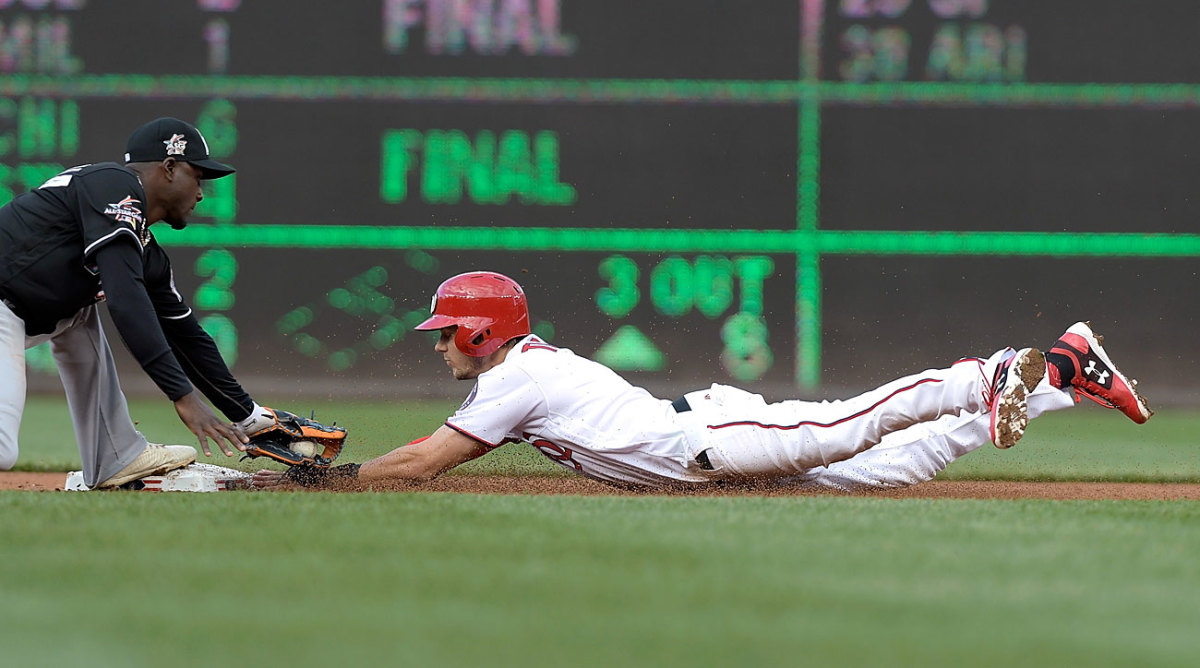Trea Burner: The Nationals' shortstop is blazing a path to success one steal at a time
As a catcher, J.T. Realmuto’s job is straightforward. The Marlins’ second-year backstop talks to his pitchers about gameplans for opposing hitters. He receives pitches and does his best to frame them as strikes. And when hitters do get on, he tries to keep them from stealing. That last task isn’t one he worries about too much. After all, the stolen base isn’t a strategy that most teams use with any regularity these days—last year saw a grand total of 2,537 swipes in the major leagues, the second-lowest mark in a full season since 1975. Realmuto faced just 79 attempted steals last season.
But while the days of Rickey Henderson and Tim Raines running wild on opposing catchers are long gone, there are still a few fleet-footed thieves who can give them fits. There’s Realmuto’s teammate, Dee Gordon, who has twice led the majors in steals. There’s Reds outfielder Billy Hamilton, one of the fastest men in the game, who has swiped 56 or more bags in each of his last three seasons.
And there’s Realmuto’s newest adversary in the National League East: 23-year-old Nationals shortstop Trea Turner, who, like Gordon and Hamilton, is wiry thin and blazing fast. After a 27-game cup of coffee in 2015, he came up for good last July and ripped off 33 steals in just 73 games—a full-season pace of 73, which would have blown away Brewers shortstop Jonathan Villar’s league-leading 62—while earning a second-place finish in the NL Rookie of the Year voting. Now atop arguably the most imposing lineup in baseball and with a license to run, Turner is ready to begin making catchers once again fear the steal.
“When there’s a guy on the opposing team who has that type of speed, you’re a little more anxious, a little more antsy when they’re on base,” Realmuto says.
And that worry comes with good reason.
“If I can get the bag,” Turner says, “I’m going to get it.”
Nationals manager Dusty Baker isn’t shy about his strategy when it comes to baserunning. “I’d love to steal every time up,” he told reporters on Opening Day as his team prepared to face the Marlins. “But you need the right guys.”
In Turner, he has just that. According to MLB.com’s Statcast data, Turner is in the top 10 of all righthanded hitters in terms of getting from home to any base; his best 2016 time for going from home to second, for example, was a blistering 7.6 seconds. Statcast also clocked Turner at a max of 22.7 mph twice last year, once on a triple and another time on an infield single. Baseball Prospectus, meanwhile, charted Turner as seventh among all major leaguers last year in Baserunning Runs, their catchall stat to measure a player’s effectiveness on the base paths.
“Sometimes it seems like he’s faster than the ball,” says Nationals catcher Matt Wieters, who faced Turner in 2016 when he was behind the plate for the Orioles (and couldn't stop Turner from stealing two bases off of him in a four-game series).
The Slugger & The Scout: How Kyle Schwarber became the consummate Chicago Cub
Baker also has the ideal man to teach Turner about the craft: Davey Lopes. Baker and Lopes, Dodgers teammates from 1976 to ’83, were reunited before the 2016 season in Washington, with Lopes coming aboard as the first-base coach. He also serves as the team's base-running expert, which is fitting for a man who owns 557 career steals, the 26th most in baseball history. As sharp a mind as there is on the subject—he served the same role for the Phillies from 2007 to '10, when they led the majors in stolen base percentage three times in those four years—Lopes, now 72, knows he has something special in Turner.
“He’s an impact player,” he says. “He can get into scoring position after one pitch and on third base after two. Anybody with the speed that he has—a Rickey Henderson, a Vince Coleman, a Willie Wilson—they change the complexion of the game.”
“Davey has so much experience, he sees things that I don’t see,” Turner says of the man who swiped 47 bases in 51 tries in 1985—at the age of 40. “He can react quicker than I can.”
It’s been 35 years since Henderson set the all-time–single-season record for steals with 130, and 30 since Coleman nabbed 109 bags, which stands as the last time a player has broken the century mark. No one has come particularly close since: Eric Davis is the only man aside from Coleman and Henderson to break 80, back in 1986, and Jacoby Ellsbury is the last to rack up 70, in 2009. Steals as a whole have declined steadily over the last 30 years, bottoming out in 2015, when there were just 2,505 in the majors—the lowest number in a full season since 1975 (2,524).
There are many reasons for the decline of the stolen base. Foremost is the sabermetric revolution, which placed increased emphasis on the value of not making outs. While the stolen base theoretically increases the likelihood of a run being scored, a caught stealing does immense damage to a team’s chances. By Run Expectancy, a runner on first with no outs is worth 0.859 runs, and a runner on second with no outs is worth 1.1—but a no-one-on, one-out situation drops that figure to 0.254. The risk largely outweighs the reward.
Statisticians determined that, for a stolen base to be worth it, the runner had to have at least a 66% chance of success, and with that, the rules of engagement quickly changed.
From 1975 to ’86, 374 players stole 25 or more bases in a season, with 42 of them failing to reach that break-even point. From 2006 to ’16, that number had fallen to 262 players with 25 or more steals—and only three of them were caught more than a third of the time. Teams were getting more restrictive about when they sent their players. In 1987, a record 3,585 bases were stolen around the league; by 2002, that had dropped to 2,750 and more or less stayed in that range since.
There are other factors besides advanced statistics. The Steroid Era brought forth a huge jump in power that made the steal unnecessary. Pitchers got better at disrupting baserunners, primarily through the adoption of the slide step, which sped up their time to the plate. Base stealers have on average a mere three seconds to snatch a bag: The ideal time for a pitcher to get the ball home is 1.3 seconds, and a catcher wants to be up and firing to a base in just under two. It all adds up to a world that’s decidedly unfriendly to runners. “There are still guys who’ll get their sneaky bags when a pitcher’s really slow, but it’s definitely slowed down,” Realmuto says.
It’s easy to see the stolen base as an antiquated weapon—a craft that only a handful of players have mastered. Few teams invest in it; two years ago, the Nationals stole just 57 bases as a team, and 21 teams last year swiped fewer than 100. But to Turner knows there's still value in the stolen base.
“It’s kind of a lost art,” he says, “until it decides a game.”
Trea Turner knew he was faster than everyone when he arrived at N.C. State in the summer of 2011 for his freshman year of college as a string bean of an infielder. In his first season, he tied an ACC record for most stolen bases in a game with five against Clemson. “He was running all over the field like the Road Runner,” says head coach Elliott Avent, who says Turner once stole a base on a pitchout. Another time, with dozens of scouts in attendance, Avent and his staff clocked Turner at 6.25 seconds in a 60-yard dash; an average runner is usually in the 6.7–6.9 range. “It’s speed you just don’t see ever,” says assistant head coach Chris Hart.
Lightly recruited out of Park Vista Community High in Lake Worth, Fla., Turner spent the next three seasons running roughshod on college catchers, stealing 113 bases in 173 games and getting caught just 14 times, an 88% success rate. That helped make him the No. 13 pick of the 2014 draft by the Padres, who then shipped him to the Nationals six months later as part of a three-team trade that sent former AL Rookie of the Year Wil Myers to San Diego and top outfield prospect Steven Souza to Tampa Bay.
As Manny Machado's talent and production grow, so does his earning power
On the field, Turner is havoc personified. Off the field, he’s reserved—he was a chemical engineering major at NC State and he counts investing in the stock market as one of his hobbies. He’s also a far cry from the brawny sluggers who are once again grabbing headlines around the sport. Listed at 6'1" and just 185 pounds, with a boyish face featuring sparsely growing facial hair, he looks like a kid who won a contest to hang out in a major league clubhouse for a day. “He’s only 15,” Baker jokes.
That slim frame, though, belies Turner’s surprising power. Last year, he slugged a Bryce Harper-esque .567 in 324 plate appearances, bashing 13 home runs. This season, despite a slow start and a hamstring injury that shelved him for two weeks in April, he’s slugging .526 and hit for the cycle against the Rockies on April 25. His speed is part of his talent for extra-base hits, helping him turn singles into doubles and doubles into triples. But he is able to rip line drives consistently using a level stroke that helps him produce lots of hard contact, separating him from the likes of Gordon and Hamilton, who have little pop.
“I never wanted to be a slap hitter. It would hurt my pride if someone called me one,” Turner says. “I wanted to be a guy who could do everything.”
But while that power makes Turner a complete hitter, it's his speed that makes him special. It’s what led the Nationals to give Turner carte blanche to run before this season, something he’s on board with. “They have a lot of confidence in me,” he says. “As many as they give (who is they?), I’d love to steal.”
The opportunities haven’t been plentiful in the early going, due in large part to the injury that shelved him for half the month—although he’s six-for-six in steals so far this season.
“If he gets on base and he wants to run, there’s no telling how many he’ll steal,” Lopes says. “Sixty won’t be anything.”
With Turner leading the way, perhaps the stolen base can make a comeback and give the sport a jolt of energy at a time when pace of play is one of baseball’s hot button topics.
“Guys like Trea, they’re fun to watch,” Lopes says. “Baseball can make you nod off a little bit. These guys have the ability to wake you up.”




































